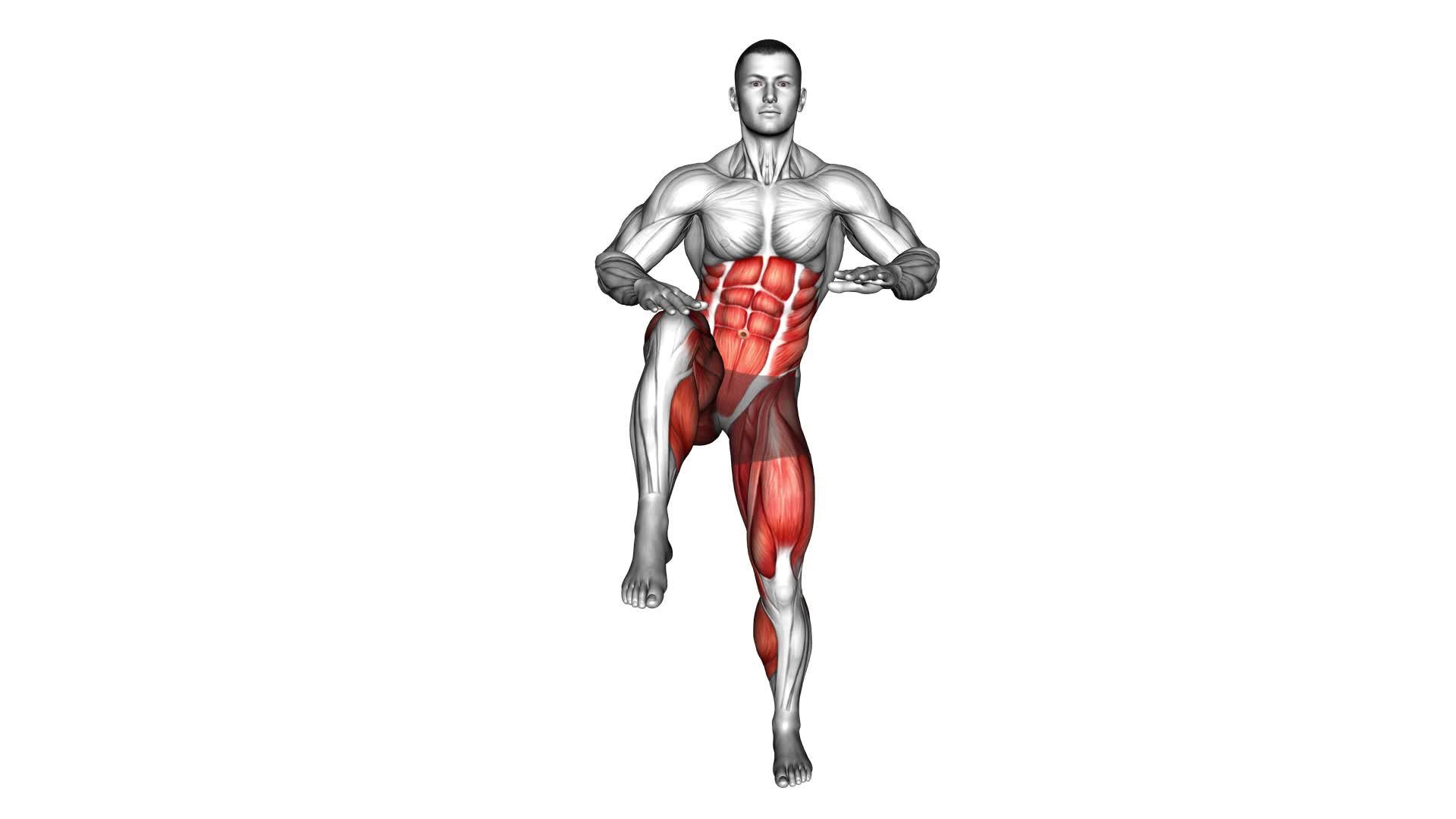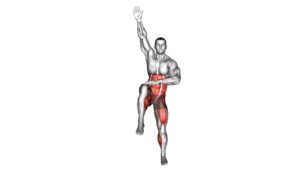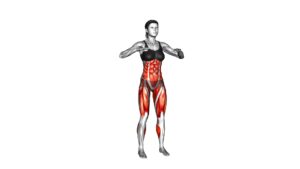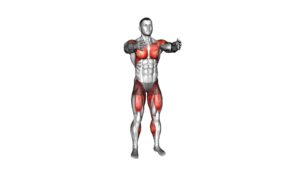High Knee Tap (male) – Video Exercise Guide & Tips

Get ready to take your workout to the next level with the High Knee Tap exercise. This dynamic move targets your lower body and boosts your cardiovascular fitness.
Watch This Exercise Video
In this video exercise guide, we'll show you the proper form and technique, as well as variations and modifications to suit your fitness level. Avoid common mistakes and maximize your results with our expert tips.
Let's get started on your journey to a stronger, fitter you!
Key Takeaways
- High knee tap exercise improves cardiovascular endurance.
- It strengthens lower body muscles such as quadriceps, hamstrings, glutes, and hip flexors.
- Engaging core muscles is a key aspect of the high knee tap exercise.
- High knee tap enhances balance and coordination.
Benefits of High Knee Tap Exercise
To maximize your workout, incorporating high knee tap exercises can provide numerous benefits for improving cardiovascular endurance and strengthening lower body muscles. High knee tap variations offer a challenging and effective way to target your quadriceps, hamstrings, glutes, and hip flexors. Unlike traditional exercises like squats or lunges, high knee taps specifically target these muscles while also engaging your core and improving your balance and coordination.
One of the main benefits of high knee tap exercises is the increased cardiovascular endurance they provide. By performing this exercise at a fast pace, you can elevate your heart rate and improve your overall cardiovascular fitness. This can be especially beneficial for athletes or individuals looking to improve their stamina and endurance.
Additionally, high knee tap exercises have the advantage of being low impact, making them suitable for individuals with joint issues or those recovering from injury. Unlike exercises like running or jumping, high knee taps put less stress on your joints while still providing a challenging workout.
Compared to other lower body exercises, high knee taps also offer a higher level of engagement for your core muscles. The act of bringing your knee up to tap your hand requires stability and control from your abdominal muscles, resulting in a stronger core over time.
Proper Form and Technique for High Knee Tap
To perform the high knee tap exercise with proper form and technique, you should begin by standing with your feet hip-width apart. Keep your core engaged and maintain a tall posture throughout the movement.
Start by lifting your right knee up towards your chest while simultaneously bending your left arm and tapping your right knee with your left hand. As you tap your knee, focus on keeping your back straight and your chest lifted. Return your right foot to the ground and repeat the movement on the other side, lifting your left knee and tapping it with your right hand.
When performing the high knee tap exercise, it's important to avoid common mistakes that can compromise your form and limit the effectiveness of the exercise. One common mistake is leaning forward or rounding your back as you lift your knee. This can put strain on your lower back and reduce the engagement of your core muscles. Another mistake is lifting your knee too high or too forcefully, which can lead to loss of balance or improper alignment. It's important to lift your knee to a comfortable height while maintaining control and stability.
Variations and Modifications for High Knee Tap
For variations and modifications of the high knee tap exercise, you can incorporate different equipment or adjust the intensity level.
One variation is to use a medicine ball while performing the exercise. Instead of tapping your knees with your hands, hold the medicine ball in front of your chest and tap your knees to the ball. This adds resistance and engages your core muscles even more.
Another variation is to perform the exercise on an unstable surface, such as a balance board or a Bosu ball. This challenges your balance and activates more stabilizer muscles.
Additionally, you can modify the intensity of the exercise by adjusting the speed or height of the knee taps. To increase the intensity, perform the knee taps at a faster pace or lift your knees higher. To decrease the intensity, slow down the movement or tap your knees lightly.
Remember to listen to your body and choose the variations and modifications that suit your fitness level and goals.
Common Mistakes to Avoid During High Knee Tap
Avoid these common mistakes when performing the high knee tap exercise.
- Improper breathing: One common mistake during the high knee tap exercise is forgetting to focus on your breathing. It's important to inhale deeply through your nose as you lift your knee, and exhale through your mouth as you tap your knee with your opposite hand. This helps to engage your core muscles and maintain stability throughout the movement.
- Leaning too far forward: Another mistake is leaning too far forward while performing the high knee tap. This can put excessive strain on your lower back and increase the risk of injury. Remember to keep your chest lifted and your torso upright throughout the exercise.
- Overstriding: Overstriding is a common mistake that can lead to injuries during the high knee tap exercise. When you take excessively large steps, you put undue stress on your hip flexors and knees. Instead, focus on taking smaller, controlled steps, and maintain a comfortable stride length.
By avoiding these common mistakes and practicing proper breathing and form, you can maximize the benefits of the high knee tap exercise while minimizing the risk of common injuries.
Always listen to your body and consult a fitness professional if you experience any pain or discomfort.
Tips for Maximizing Results With High Knee Tap
Maximize your results with the high knee tap exercise by focusing on proper form and incorporating these tips. To maximize intensity, engage your core and keep your chest lifted throughout the exercise. This will help you maintain stability and amplify the benefits of the movement. Additionally, make sure to fully extend your leg with each tap, driving your knee up towards your chest and tapping your opposite hand to it. This will ensure that you're engaging your leg muscles and promoting a full range of motion.
To further maximize your results, consider incorporating high knee tap into your HIIT (High-Intensity Interval Training) workouts. This exercise is a great way to elevate your heart rate, burn calories, and improve cardiovascular endurance. You can incorporate high knee tap into your HIIT routine by performing it for a set amount of time, such as 30 seconds, followed by a short rest period. Repeat this sequence for multiple rounds to create an effective and challenging workout.
Sample High Knee Tap Workout Routine
To create an effective high knee tap workout routine, incorporate the exercise into your existing fitness regimen and focus on maintaining proper form throughout.
High knee taps are a great way to improve cardiovascular endurance and strengthen your lower body muscles. Here is a sample workout routine to help you get started:
- Warm up: Begin with a five-minute dynamic warm-up, such as jogging or jumping jacks, to prepare your body for the workout.
- High knee tap progressions: Start with a basic high knee tap exercise, lifting your knees to hip level and tapping them with your hands. As you progress, you can increase the speed and height of your knee lifts, or add a hop between each tap for an extra challenge.
- Circuit training: Incorporate high knee taps into a circuit training routine by alternating them with other exercises such as push-ups, squats, or jumping lunges. Perform each exercise for 30 seconds to one minute, with a short rest in between, and repeat the circuit for three to four rounds.
- Cool down: Finish your workout with a five-minute cooldown, such as walking or stretching, to help your body recover.
Frequently Asked Questions
What Is the Best Time of Day to Perform the High Knee Tap Exercise?
The best time of day to perform the high knee tap exercise is whenever it fits into your schedule and you feel most energized.
This exercise has numerous benefits, such as improving cardiovascular fitness and strengthening the lower body muscles.
There are different variations you can try to make it more challenging, and proper form is essential to avoid injury.
Common mistakes include not lifting the knees high enough or leaning forward.
Advanced techniques can involve adding weights or increasing the speed.
Can High Knee Tap Help in Reducing Belly Fat?
High knee tap is a great exercise for reducing belly fat. By engaging your core and raising your heart rate, it helps burn calories and fat. The exercise targets your abdominal muscles, helping to strengthen and tone them.
High knee tap benefits include improved balance, coordination, and cardiovascular endurance. You can also modify the exercise by adding variations like twisting your torso or using weights to increase the intensity.
Is It Necessary to Warm up Before Performing the High Knee Tap Exercise?
Before performing the high knee tap exercise, it's necessary to warm up. Warming up helps prepare your muscles and joints for the workout, reducing the risk of injury. It also increases blood flow and flexibility, allowing for better performance.
Benefits of warming up include improved muscle function and range of motion. Additionally, modifications can be made to suit your fitness level or any physical limitations you may have.
Remember to always consult with a professional before starting any new exercise routine.
Can High Knee Tap Be Performed by Beginners?
Yes, high knee tap can be performed by beginners. It's a great exercise that offers numerous benefits such as improving cardiovascular fitness, strengthening the lower body, and enhancing coordination.
To make it more beginner-friendly, you can start by performing the exercise at a slower pace and gradually increase the speed as you become more comfortable. Additionally, you can modify the exercise by reducing the height of the knee tap or performing it with a support, like a chair, for balance.
How Long Should One Rest Between Sets of High Knee Tap Exercise?
To maximize the benefits of the high knee tap exercise, it's important to consider the rest duration between sets. Resting for around 30 to 60 seconds is recommended to allow your muscles to recover and replenish energy.
This short rest period helps maintain the intensity of the workout while also preventing excessive fatigue. By giving yourself enough time to rest between sets, you'll be able to perform the exercise effectively and continue reaping its benefits.
Conclusion
In conclusion, the high knee tap exercise is a great way to improve cardiovascular fitness and strengthen the lower body muscles. By following proper form and technique, you can maximize the effectiveness of this exercise.
Remember to avoid common mistakes and consider incorporating variations and modifications to keep challenging yourself. With consistency and dedication, the high knee tap can be a valuable addition to your workout routine.

Author
Years ago, the spark of my life’s passion ignited in my mind the moment I stepped into the local gym for the first time. The inaugural bead of perspiration, the initial endeavor, the very first surge of endorphins, and a sense of pride that washed over me post-workout marked the beginning of my deep-seated interest in strength sports, fitness, and sports nutrition. This very curiosity blossomed rapidly into a profound fascination, propelling me to earn a Master’s degree in Physical Education from the Academy of Physical Education in Krakow, followed by a Sports Manager diploma from the Jagiellonian University. My journey of growth led me to gain more specialized qualifications, such as being a certified personal trainer with a focus on sports dietetics, a lifeguard, and an instructor for wellness and corrective gymnastics. Theoretical knowledge paired seamlessly with practical experience, reinforcing my belief that the transformation of individuals under my guidance was also a reflection of my personal growth. This belief holds true even today. Each day, I strive to push the boundaries and explore new realms. These realms gently elevate me to greater heights. The unique combination of passion for my field and the continuous quest for growth fuels my drive to break new ground.







